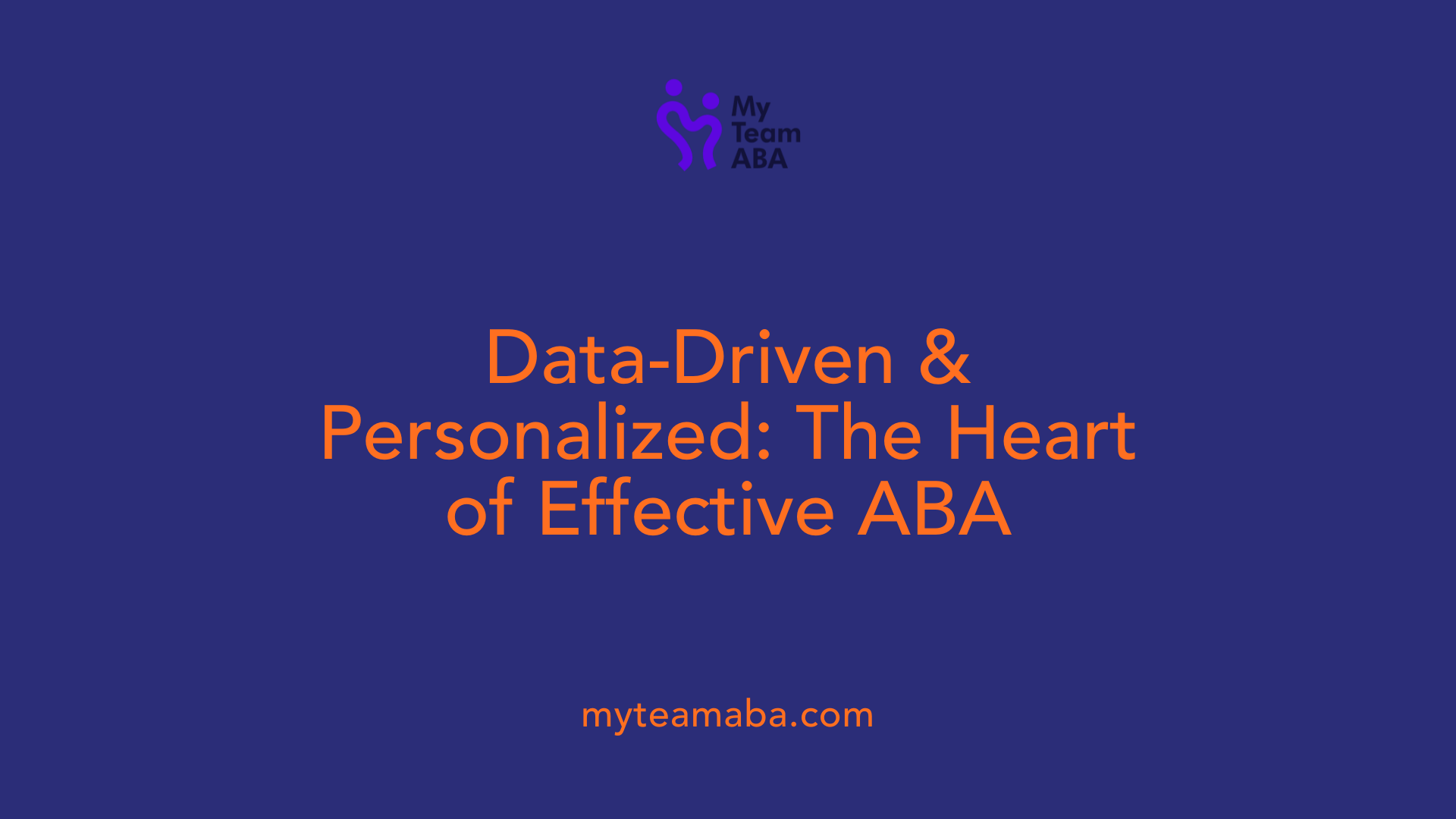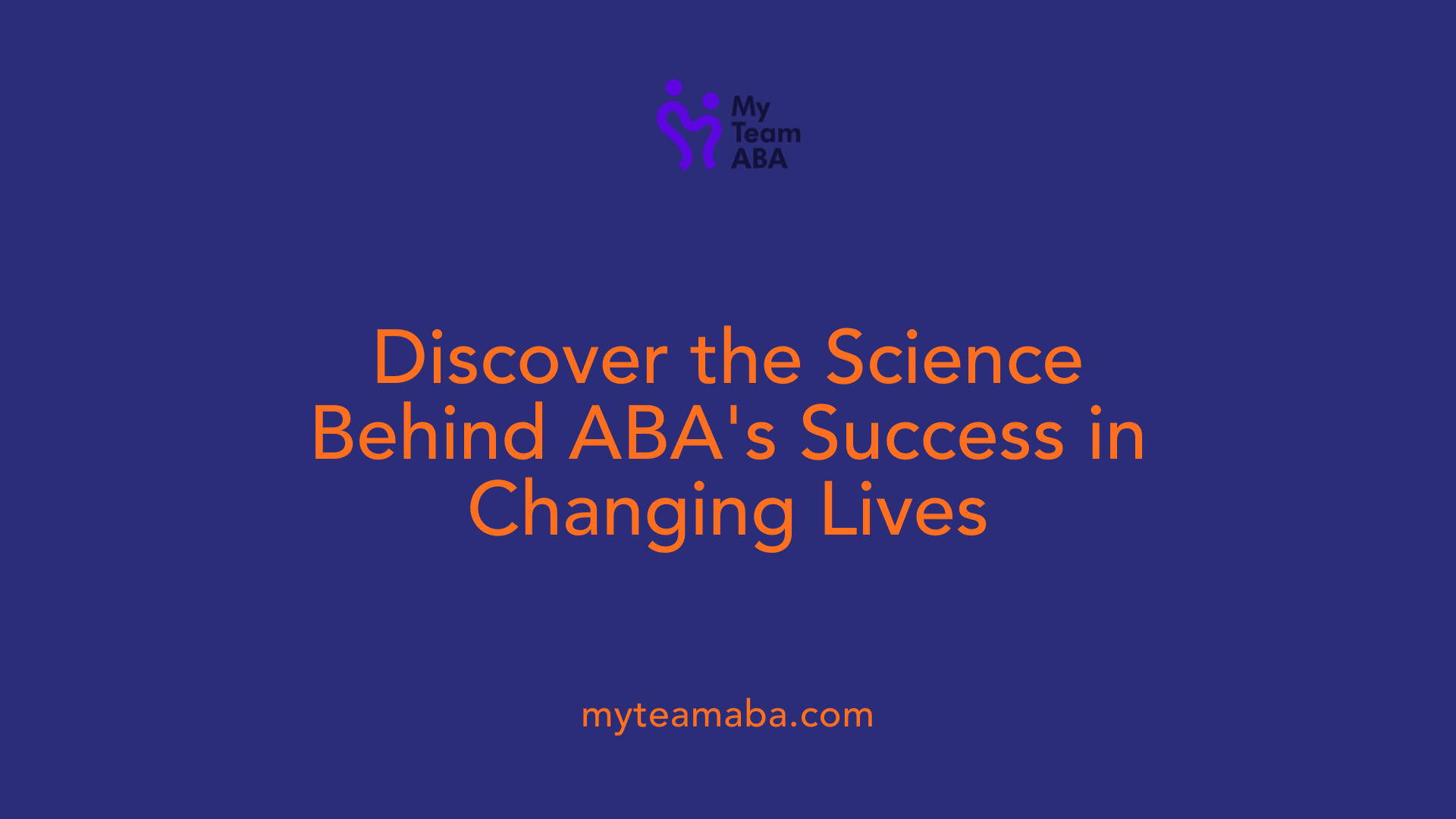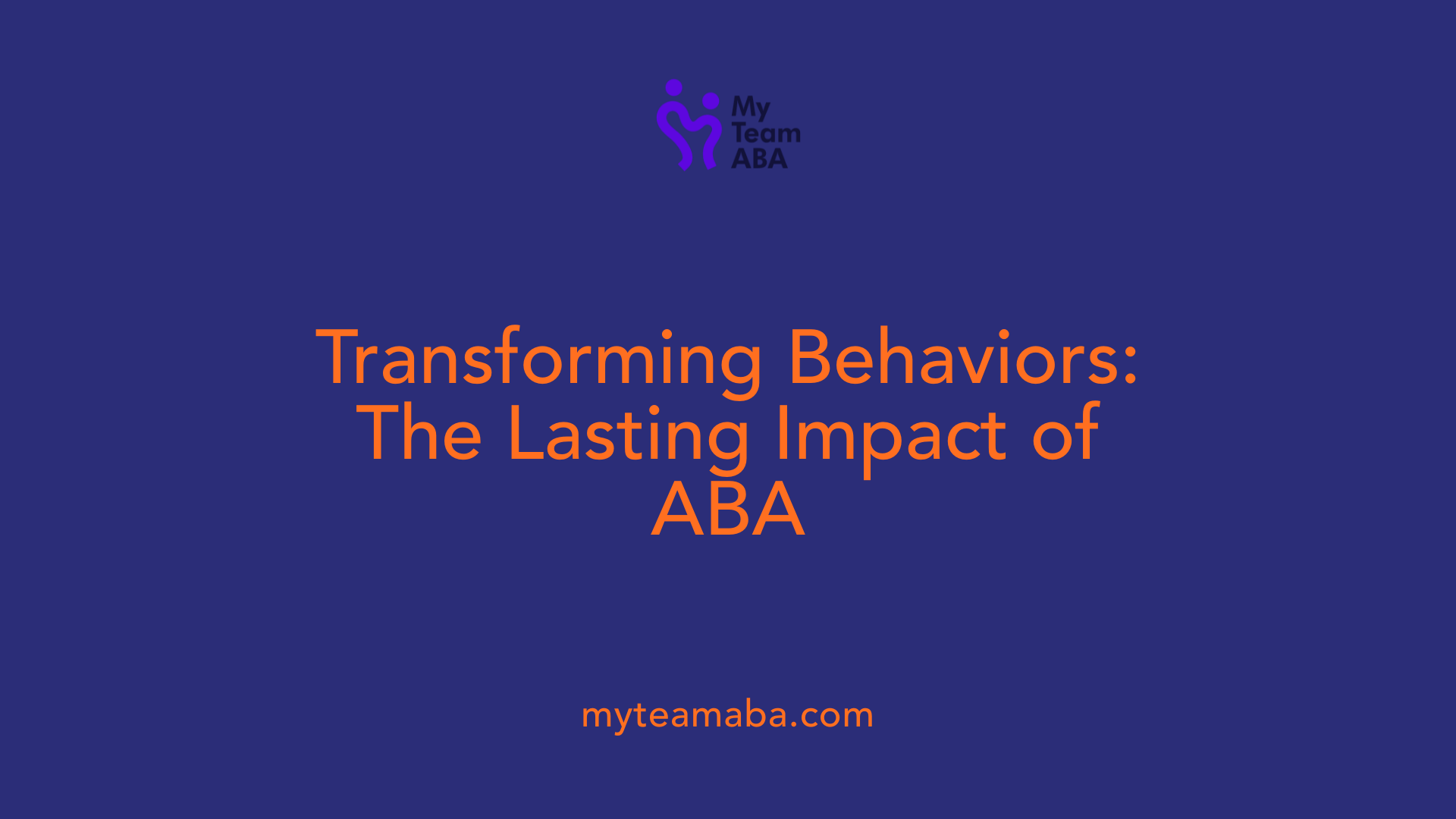The Role of ABA Therapy in Promoting Positive Behavior Changes
August 1, 2025
Harnessing Scientific Principles for Lasting Change

Understanding ABA and Its Impact on Behavior
Applied Behavior Analysis (ABA) is a scientifically validated and evidence-based method that plays a pivotal role in transforming behaviors, especially in individuals with autism spectrum disorder (ASD). By systematically applying learning principles, ABA aims to foster positive behaviors, reduce problematic ones, and enhance overall quality of life. This article explores the techniques, principles, applications, and success stories associated with ABA therapy, elucidating its central role in behavior modification and development.
Fundamentals of ABA: A Scientific Approach to Behavior
What is the role of ABA therapy in promoting positive behavior changes?
Applied Behavior Analysis (ABA) therapy is a scientific approach that focuses on understanding how behavior is influenced by environmental factors. Its primary role is to bring about positive behavior changes through systematic intervention.
ABA employs proven techniques such as positive reinforcement, prompting, modeling, and functional behavior assessments. These methods help teach new skills and diminish problematic behaviors by modifying the environment in ways that support desired behaviors.
The therapy is highly tailored to each individual, often developed through detailed assessments that identify specific triggers and reinforcers. This customization ensures that interventions are effective and sustainable.
Through consistent data collection and ongoing analysis, ABA professionals make adjustments to optimize results, enabling individuals to improve important skills like communication, social interaction, cognition, and daily living.
In practice, ABA involves collaboration with families and caregivers, who are equipped with strategies to reinforce positive behaviors across various settings, such as home, school, and community. This collaborative approach ensures that gains are maintained and generalized.
Overall, ABA’s role extends beyond behavior change; it aims to empower individuals, promote independence, and improve their quality of life. Its evidence-based foundation makes it a trusted and effective method for supporting individuals with autism and developmental difficulties.
Techniques and Principles of ABA in Practice
 Applied Behavior Analysis (ABA) employs a variety of evidence-based techniques to foster positive behavior change, especially in individuals with autism spectrum disorder (ASD). These methods are grounded in a scientific understanding of learning processes and environmental influences.
Applied Behavior Analysis (ABA) employs a variety of evidence-based techniques to foster positive behavior change, especially in individuals with autism spectrum disorder (ASD). These methods are grounded in a scientific understanding of learning processes and environmental influences.
One of the main strategies in ABA is reinforcement, which involves providing a positive consequence to increase the likelihood of a behavior recurring. Both positive reinforcement—like praise, tokens, or preferred activities—and negative reinforcement, which removes an unpleasant stimulus, are used depending on the context and individual needs.
To promote independence and skill acquisition, ABA utilizes prompting, such as physical guidance or verbal cues, followed by systematic fading to reduce assistance over time. Behavior chaining is another vital technique that breaks down complex tasks into manageable steps, teaching each component sequentially until the entire behavior is mastered.
Modeling and video modeling serve as powerful tools for demonstrating desired behaviors. Therapists or caregivers show the individual how to perform specific tasks, often recording videos for repeated viewing. Behavior scripts, which are detailed sequences of expected behaviors, help guide responses in social or routine settings.
Data collection is central to ABA, with ongoing measurement of behavior to assess progress and inform adjustments. Personalized programs are developed based on functional assessments that analyze antecedents, behaviors, and consequences to define effective intervention plans.
Environmental modifications and supportive strategies such as redirection, extinction of undesired behaviors, and the use of behavior contracts further enhance the effectiveness of ABA. These tactics are combined within a structured framework to promote skill generalization across different settings and ensure sustained improvements.
Overall, ABA's systematic approach, combining precise techniques and continuous data analysis, aims to optimize social, communicative, and functional skills tailored to each individual's unique requirements.
Understanding ABA’s Focus on Data and Individualization

What is the role of ABA therapy in promoting positive behavior changes?
ABA therapy is a scientific method that emphasizes understanding and changing behavior through systematic assessment and intervention. Its core involves collecting detailed data on an individual's behavior to identify patterns, triggers, and consequences that influence actions.
This approach allows for the design of personalized plans tailored to each person's specific needs. Technicians and behavior analysts use functional behavior assessments to determine the underlying reasons for behaviors, whether they are social, communicative, or functional.
Interventions are then crafted with techniques like positive reinforcement, prompting, and modeling, all based on the collected data. These strategies aim to teach new skills, improve existing ones, and diminish problematic behaviors.
Through continuous monitoring and analysis of behavioral data, ABA professionals can adjust interventions as needed, ensuring each program remains effective and responsive.
This individualized, data-driven process helps individuals, especially children with autism, achieve improvements in social skills, communication, and daily functioning. Collaboration with families and caregivers is also vital in reinforcing positive changes across different environments.
In summary, the goal of ABA is to foster meaningful, lasting behavior improvements by systematically understanding each person’s unique profile and applying scientifically supported strategies.
Behavioral Interventions and Their Application
How does ABA therapy contribute to behavior modification and development?
Applied Behavior Analysis (ABA) therapy is a scientifically grounded approach that focuses on understanding and influencing behavior. It plays a vital role in helping individuals develop socially significant skills and reduce problematic behaviors. ABA uses principles of operant and respondent conditioning to craft personalized intervention plans tailored to each person's unique needs.
A core element of ABA is the systematic teaching of new skills, which can include improving communication, social interaction, academic abilities, and daily living skills. Simultaneously, ABA aims to decrease maladaptive behaviors by employing strategies such as positive reinforcement, prompting, and task analysis.
One of the strengths of ABA is its rigorous data collection and ongoing assessment process. These allow practitioners to evaluate the effectiveness of interventions continuously, adjusting techniques as necessary for maximum benefit.
The therapy promotes the generalization of skills across different environments, ensuring that behavioral changes are meaningful and sustainable in daily life. Ongoing collaboration with families and educators further supports the transfer of new skills into real-world settings.
Research consistently demonstrates that ABA significantly enhances independence, social functioning, and quality of life—especially for individuals with autism spectrum disorder (ASD). Through its comprehensive and individualized approach, ABA remains a cornerstone in behavior modification and developmental advancement.
What are some specific behavioral techniques used in ABA?
| Technique | Description | Example |
|---|---|---|
| Positive Reinforcement | Rewarding desired behaviors to encourage repetition | Praising a child for sharing toys |
| Behavior Chaining | Connecting simple behaviors into complex tasks | Teaching dressing step-by-step |
| Task Analysis | Breaking down skills into manageable parts | Teaching hand-washing by steps |
| Prompting | Providing cues to evoke a desired response | Giving verbal hints during a learning activity |
| Data Collection | Monitoring progress through systematic recording | Tracking frequency of social interactions |
How does applied behavior analysis help in classroom settings?
In educational environments, ABA guides the development of targeted intervention plans that address individual needs. Collaboration among teachers, special education professionals, and behavior analysts is essential.
ABA helps create inclusive and supportive classrooms by reinforcing positive behaviors, improving social skills, and reducing disruptive behaviors. Strategies like visual supports, structured teaching, and reinforcement are common, enabling all students to thrive.
The overall goal is to foster a learning environment where every student can succeed and participate actively, leading to improved academic and social outcomes.
ABA’s Impact in Educational and Developmental Settings
How effective is ABA therapy in educational and developmental contexts?
Applied Behavior Analysis (ABA) has proven to be a powerful method for supporting children’s growth and development, especially those diagnosed with autism spectrum disorder (ASD). Its systematic approach, grounded in scientific principles, has demonstrated significant improvements in key areas such as social interactions, communication skills, and adaptive behaviors.
Research consistently shows that children receiving ABA therapy experience measurable gains. For example, intensive interventions often lead to increased social engagement and better communication abilities. In many cases, children demonstrate improvements in daily living skills and emotional regulation, which are crucial for independent functioning.
The success of ABA in educational environments depends largely on personalized treatment plans and ongoing data collection. Studies, including meta-analyses, reveal small to moderate progress across various behavioral and developmental metrics. Notably, the number of intervention hours correlates positively with outcomes, highlighting the importance of consistent implementation.
School-based ABA programs are designed to integrate seamlessly with traditional education. These programs facilitate positive behavior change and promote independence through proven strategies like Discrete Trial Training (DTT), Natural Environment Teaching (NET), and customized behavior plans. They foster environments that encourage student participation, reduce problem behaviors, and build essential life skills.
Overall, ABA’s rigorous, evidence-based approach effectively supports diverse learning needs. It helps children achieve meaningful progress in their social, communicative, and adaptive functioning, paving the way for improved quality of life.
School-based ABA programs
In schools, ABA is used to develop tailored interventions that promote positive behaviors and reduce challenges. These programs involve collaboration among teachers, behavior analysts, and support staff to create environments conducive to learning.
Enhancement of social and communication skills
ABA employs techniques like social skills training and language development strategies which have shown to significantly enhance communication and social participation for children with ASD.
Assessment of intervention outcomes
Continuous data monitoring and functional assessments enable educators and therapists to refine interventions, ensuring sustained progress and relevance to each student’s evolving needs.
| Aspect of ABA in Education | Description | Impact |
|---|---|---|
| Personalized Learning Plans | Tailored strategies based on individual assessments | Improved engagement and skills |
| Data-Driven Adjustments | Ongoing analysis of behavioral data | Enhanced intervention effectiveness |
| Collaboration | Teamwork among educators, psychologists, and families | Consistent support and reinforcement |
| Focus Areas | Social skills, communication, daily living | Broader developmental gains |
This comprehensive approach, rooted in scientific research, makes ABA a trusted and effective method to foster positive change in educational and developmental settings.
Research Evidence Supporting ABA’s Benefits

What does research say about the impact of ABA therapy on social and emotional development?
Extensive research has demonstrated that ABA therapy can significantly improve social and emotional skills in individuals with autism spectrum disorder (ASD). One of the main strengths of ABA is its focus on helping individuals develop essential social skills such as sharing attention, understanding social cues, and engaging in meaningful interactions.
Specific ABA techniques like social narratives, comic strip conversations, social scripts, and the use of the hidden curriculum are employed to teach social understanding and emotional regulation. These tools help individuals interpret nonverbal signals, manage their emotions, and respond appropriately in social settings.
Studies indicate that children receiving ABA therapy often show progress in requesting help, recognizing others’ feelings, and controlling impulsive behaviors. Such improvements can lead to better social engagement, increased independence, and improved quality of life.
Modern ABA approaches are increasingly person-centered, emphasizing strengths and respecting neurodiversity. Instead of solely aiming to modify behavior through conformity, current practices encourage authentic social interactions and emotional understanding.
The benefits of early and tailored intervention are well-supported by scientific evidence. When ABA programs are customized to meet each individual's unique needs, children tend to develop more adaptive behaviors and gain confidence in social situations.
Overall, the research affirms that ABA is a powerful tool for fostering social and emotional growth in children and adults with ASD, especially when interventions are applied early, systematically, and with an emphasis on person-centered strategies.
Success Stories and Real-World Outcomes with ABA
Can you share success stories or real-world examples demonstrating the benefits of ABA?
Applied Behavior Analysis (ABA) has many documented success stories showcasing its positive impact on children with autism spectrum disorder (ASD). These stories highlight how tailored, evidence-based interventions can significantly improve communication, social skills, independence, and overall quality of life.
One notable example is Kevin, a young boy diagnosed with ASD who initially struggled with scripting repetitive phrases and exhibited routine obsessions. After several months of consistent ABA therapy, Kevin made remarkable progress. He transitioned from scripted speech to engaging in full conversations, reading simple books, and actively participating in classroom activities. His family reported increased emotional awareness and reduced challenging behaviors, which made daily interactions more positive and fulfilling.
Other children, like Ben and Sarah, have also shown impressive improvements. Ben, who previously used hand signals and had difficulty with social interactions, began making eye contact, speaking in complete sentences, and forming friendships within his community. Sarah, who faced challenges with communication and was initially non-verbal, learned to express herself verbally and took part in extracurricular activities.
These outcomes are made possible by personalized ABA programs that focus on individual needs and set small, manageable goals. Continuous data collection, behavioral assessments, and close collaboration with families ensure that interventions are effective and sustainable.
Overall, these stories demonstrate that with early intervention and consistent application of ABA principles, children with ASD can develop essential skills, gain independence, and lead more engaged lives. This evidence underscores the importance of ABA as a scientifically supported approach to transforming lives, producing meaningful, lasting improvements for many individuals.
Addressing Challenges and Future Outlook of ABA
What challenges exist in implementing ABA and how can they be addressed?
Implementing Applied Behavior Analysis (ABA) faces several hurdles. One of the primary challenges is limited awareness among communities, families, and even some professionals about the scientific basis and benefits of ABA. This can result in low acceptance and adoption of the therapy.
Furthermore, there is often a significant gap in professional training. Many regions lack adequate programs to train practitioners thoroughly in ABA principles, which is essential for delivering effective interventions. The high cost of therapy sessions and necessary training also restricts access, especially in developing areas.
Cultural factors add another layer of complexity. Different societies have varying perceptions of behavioral interventions and autism, which can influence how ABA is perceived and used. Tailoring approaches to respect cultural norms while maintaining scientific rigor is necessary.
Despite these challenges, ongoing research and technological innovation are making strides. New methods aim to improve the affordability and adaptability of interventions. Efforts to increase public awareness, coupled with investments in professional development, are crucial.
Increasing access involves integrating ABA into existing educational systems and healthcare services, making it more accessible and acceptable. Community engagement and culturally sensitive practices can help bridge gaps.
Future developments and ongoing research
Looking ahead, the future of ABA appears promising. Researchers are exploring new tools and technologies, such as digital applications and data collection tools, to enhance therapy effectiveness and scalability.
There is also a growing body of evidence demonstrating the benefits of early intervention, which encourages earlier adoption of ABA strategies. Innovations aim to personalize interventions further and make them more engaging.
In summary, overcoming current barriers requires a multi-faceted approach: raising awareness, improving training, cultural adaptation, and investing in research.
With these efforts, ABA can reach more individuals who benefit from its scientifically supported strategies, ultimately improving quality of life and fostering inclusive communities worldwide.
Overview of challenges and strategies in ABA implementation
| Challenge | Impact | Possible Solutions | Additional Notes |
|---|---|---|---|
| Limited awareness | Low acceptance and use | Education campaigns, community outreach | Raises understanding of ABA’s benefits |
| Professional training gaps | Variable intervention quality | Expand training programs, online courses | Ensures effective application of ABA techniques |
| Cost and accessibility | Limited reach in low-resource areas | Subsidies, government support, telehealth | Makes ABA more economically feasible |
| Cultural perceptions | Resistance to intervention | Cultural-sensitive adaptation, engagement | Enhances acceptance across diverse communities |
| Technological barriers | Challenges in data collection and analysis | Develop user-friendly digital tools | Advances in tech can improve efficiency and engagement |
Final thoughts
The future of ABA hinges on concerted efforts to tackle these challenges. By fostering greater awareness, expanding training, and leveraging technology, ABA can become more accessible and impactful. Continued collaboration among researchers, practitioners, and communities will shape a future where behavioral interventions are more inclusive and scientifically grounded.
The Integration of ABA with Broader Educational Strategies

How do collaborative approaches improve the use of ABA in classrooms?
Collaborative approaches in classrooms involve active participation from teachers, special education professionals, behavior analysts, and support staff. This teamwork ensures that ABA interventions are deeply personalized, consistent, and effective. When educators work together, they can develop tailored learning plans that address each student's unique needs, leading to more meaningful behavioral improvements.
Why is involving families crucial for successful ABA implementation?
Family involvement plays a vital role in maintaining the progress achieved through ABA therapy. Families are trained in reinforcement techniques, antecedent modifications, and data tracking, enabling consistent support across home and school environments. This consistency helps reinforce positive behaviors and ensures sustained behavioral change over time.
How can integrating ABA promote inclusive education?
Applying ABA principles within inclusive education settings helps create environments where all students, especially those with autism spectrum disorder, feel supported and valued. Techniques like visual supports, communication strategies, and reinforcement are used to facilitate social engagement and learning for everyone. Proper training ensures that educators can implement these strategies effectively, making classrooms more welcoming and inclusive.
By fostering cooperation among educators, families, and support systems, ABA can be effectively embedded into broader educational strategies. This integration boosts students' social skills, communication abilities, and overall participation, promoting a more inclusive and supportive learning environment.
Summary and Final Thoughts on ABA's Role in Behavior Change

What are the main principles of ABA?
Applied Behavior Analysis (ABA) is a scientific approach focused on understanding behavior through detailed assessment. It employs techniques like reinforcement, prompting, and modeling, tailored to individual needs. Data collection and analysis are ongoing processes that help refine interventions to ensure effectiveness. The core idea is to promote meaningful, lasting change by systematically modifying environmental factors and reinforcing positive behaviors.
How does ABA support behavior improvement?
ABA primarily targets socially significant behaviors, such as communication, social skills, and daily living skills. It is especially impactful in early intervention, helping children with autism spectrum disorder (ASD) improve their skills and reduce challenging behaviors. Through structured, personalized programs and collaboration with families and educators, ABA creates supportive environments that foster growth.
What is the role of positive reinforcement?
Positive reinforcement is a central component of ABA. It involves rewarding desired behaviors with praise or preferred items, which increases the likelihood of these behaviors recurring. This method is highly effective, encouraging not only skill acquisition but also social engagement and self-regulation.
How does ABA differ from Positive Behavior Support (PBS)?n
PBS shares similar values such as respect and dignity but is often influenced more by ideological and marketing interests than by scientific evidence. It emphasizes environmental supports and lifestyle changes, sometimes lacking the technical rigor of ABA. Despite their shared goals, PBS often does not explicitly acknowledge its foundation in ABA, and its methodologies may rely more on informal measures.
What is the research backing ABA?
Extensive research supports ABA as a scientifically validated approach. It has demonstrated success in improving communication, social skills, and daily functioning in children with ASD and other developmental disorders. Continuous data-driven assessment ensures interventions are effective and adaptable, making ABA a trusted method worldwide.
How does ABA integrate into education and family support?
In classrooms, ABA-based interventions foster inclusive, supportive learning environments by creating individualized plans and promoting collaboration among teachers, special educators, and behavior analysts. For families, training in ABA techniques—such as positive reinforcement and data tracking—empowers parents to support consistent, positive behavioral changes at home.
| Key Aspects | Description | Additional Details |
|---|---|---|
| Core Principles | Data collection, reinforcement, prompting | Basis for systematic intervention |
| Target Behaviors | Communication, social skills, daily living | Focus on meaningful improvements |
| Settings | Homes, schools, clinics | Versatile application |
| Effectiveness | Proven through extensive research | Short- and long-term benefits |
| Implementation | Individualized, collaborative | Tailored to needs and contexts |
| Challenges | Access, awareness, cultural factors | Opportunities for growth |
Final thoughts
ABA remains a highly effective, evidence-based approach that transforms lives through positive reinforcement and systematic behavior intervention. Its scientifically grounded techniques make it a reliable choice for supporting individuals with behavioral challenges, especially those with ASD. While other approaches like PBS share similar values, ABA's rigorous methodology continues to lead in behavior change practices.
Unlocking Potential Through Evidence-Based Interventions
Applied Behavior Analysis (ABA) stands as a cornerstone of scientifically grounded behavior intervention, demonstrating immense promise in promoting positive, sustainable behavior changes. Its comprehensive framework, which includes meticulously designed techniques, data-driven assessments, and individualized strategies, ensures that interventions are both effective and adaptable. From enhancing social skills and emotional regulation to fostering independence in real-world settings, ABA continues to positively impact individuals with ASD and broader developmental challenges. As research advances and awareness grows, the future of ABA lies in innovative, culturally sensitive, and accessible practices that unlock human potential across diverse communities.
References
- Positive Behavior Support and Applied Behavior Analysis - PMC
- Enhancing Classroom Success: The Impact of ABA Therapy on ...
- Promoting Positive Behavior: The Role of Applied Behavior Therapy ...
- The effectiveness of applied behavior analysis program training on ...
- ABA Therapy Breakthroughs: Paving the Way for Positive Behavioral ...
- Revealing Positive Reinforcement's Efficacy - ABA Compass
- The effectiveness of applied behavior analysis program training on ...
- Patient Outcomes After Applied Behavior Analysis for Autism ...
- Applied Behavior Analysis (ABA) | Autism Speaks
